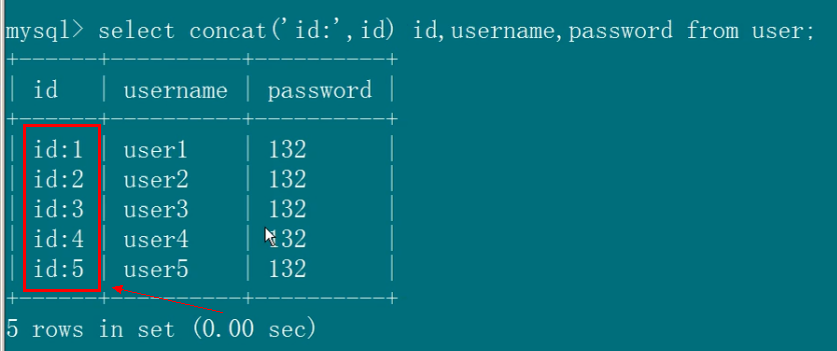mysql数据库优化课程---9、php用什么写的
一、总结
一句话总结:php是用c语言写的,所以php里面的那些模块什么都是c语言
c语言:php是用c语言写的,所以php里面的那些模块什么都是c语言
2、google搜索和百度搜索的区别是什么?
google:质量
百度:资金
google搜索偏向自由,好东西通过关键词就能搜出来
百度的话主要偏向资金,你给的钱多,你的搜索排名就高
3、mysql中如何查询为null的行和不为null的行?
is null
is not null
1.查询值为null的行
select * from user where password is null;
2.查询值不为null的行
select * from user where password is not null;
因为null不能做比较,所以=null是错的
4、mysql中如何使用limit限定输出条数?
limit m,n
使用limit限定输出条数:
1)前5条
select * from user limit 5;
select * from user limit 0,5;
2)从第四条取3条:
select * from user limit 3,3;
5、delete与truncate的区别是什么?
truncate清除计数器:truncate是直接删除表,delete是一行一行的删除,多以truncate速度快的多,所以truncate也会清除计数器
truncate是直接删除表,delete是一行一行的删除,多以truncate速度快的多,所以truncate也会清除计数器
1.delete清空表数据,但不会清除计数器(自增)
delete from user;
2.truncate清空表数据,同时会清除计数器(自增)
truncate user;
6、统计查找的数据的总函数?
count(*):select count(*) from user;
注意这里这个括号的用法
#统计表总行数:
select count(*) from user;
select count(id) from user;
#统计符合条件的行数:
select count(*) from user where id>2;
7、mysql如何让查出来的字段连接其它字符串,比如在id前面加上id:?
连接函数concat:concat('id:',id) id
最后一个id表示列的别名
连接函数concat:
1)
select concat('id:',id) id,concat('user:',username) user,concat('pass:',password) pass from user;
2)
select id,username,password,concat(id,'-',username,'-',password) iduserpass from user;
3)
select (id-1) as id,username,password from user;
8、linux命令行中怎样是复制?
选中:直接选中就是复制了,然后点右键就是粘贴
9、如何从数据库取出来的数据修改索引之后才返回给调用的位置?
(id-1) as id
select (id-1) as id,username,password from user;
mysql里面支持查询语句列的加减乘除等这些操作
二、内容在总结中
1.查询值为null的行
select * from user where password is null;
2.查询值不为null的行
select * from user where password is not null;
3.使用order by对查询结果排序
#排序分为升序(asc)(从小到大)和降序(desc)(从大到小)
1)升序
select * from user order by id;
select * from user order by id asc;
2)降序
select * from user order by id desc;
使用limit限定输出条数:
1)前5条
select * from user limit 5;
select * from user limit 0,5;
2)从第四条取3条:
select * from user limit 3,3;
delete与truncate的区别:
1.delete清空表数据,但不会清除计数器(自增)
delete from user;
2.truncate清空表数据,同时会清除计数器(自增)
truncate user;
连接函数concat:
1)
select concat('id:',id) id,concat('user:',username) user,concat('pass:',password) pass from user;
2)
select id,username,password,concat(id,'-',username,'-',password) iduserpass from user;
3)
select (id-1) as id,username,password from user;
随机数rand函数:
select * from user order by rand() limit 1;
统计个数count函数:
#统计表总行数:
select count(*) from user;
select count(id) from user;
#统计符合条件的行数:
select count(*) from user where id>2;
求和sum():
select sum(id) from user;
平均值avg():
select avg(id) from user;
最大值max():
select max(id) from user;
最小值min():
select min(id) from user;
user表数据:
+----+----------+----------+-------+
| id | username | password | class |
+----+----------+----------+-------+
| 1 | user1 | 123 | 1 |
| 2 | user2 | 123 | 1 |
| 3 | user3 | 123 | 1 |
| 4 | user4 | 123 | 2 |
| 5 | user5 | 123 | 1 |
| 6 | user6 | 123 | 3 |
| 7 | user7 | 123 | 2 |
| 8 | user8 | 123 | 1 |
| 9 | user9 | 123 | 3 |
| 10 | user10 | 123 | 1 |
+----+----------+----------+-------+
group by分组聚合的使用:
#按条件进行分组,然后在分组的基础上进行有条件的聚合.
把每个班的第一个人取出来:
mysql> select * from user group by class;
+----+----------+----------+-------+
| id | username | password | class |
+----+----------+----------+-------+
| 1 | user1 | 123 | 1 |
| 4 | user4 | 123 | 2 |
| 6 | user6 | 123 | 3 |
+----+----------+----------+-------+
统计每个班的总人数:
mysql> select concat(class,' 班') 班级,concat(count(*),' 人') 人数 from user group by class;
+--------+--------+
| 班级 | 人数 |
+--------+--------+
| 1 班 | 6 人 |
| 2 班 | 2 人 |
| 3 班 | 2 人 |
+--------+--------+
7、mysql如何让查出来的字段连接其它字符串,比如在id前面加上id:?

concat('id:',id) id
最后一个id表示列的别名
连接函数concat:
1)
select concat('id:',id) id,concat('user:',username) user,concat('pass:',password) pass from user;
2)
select id,username,password,concat(id,'-',username,'-',password) iduserpass from user;
3)
select (id-1) as id,username,password from user;